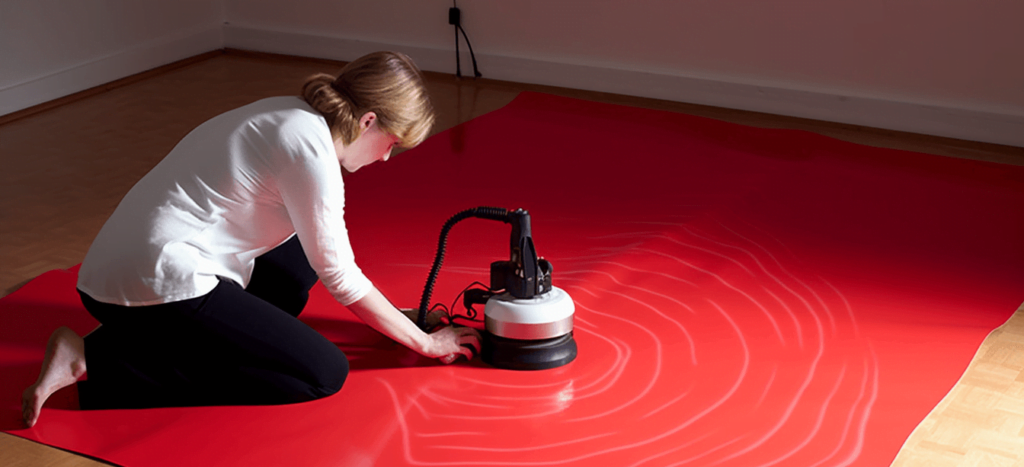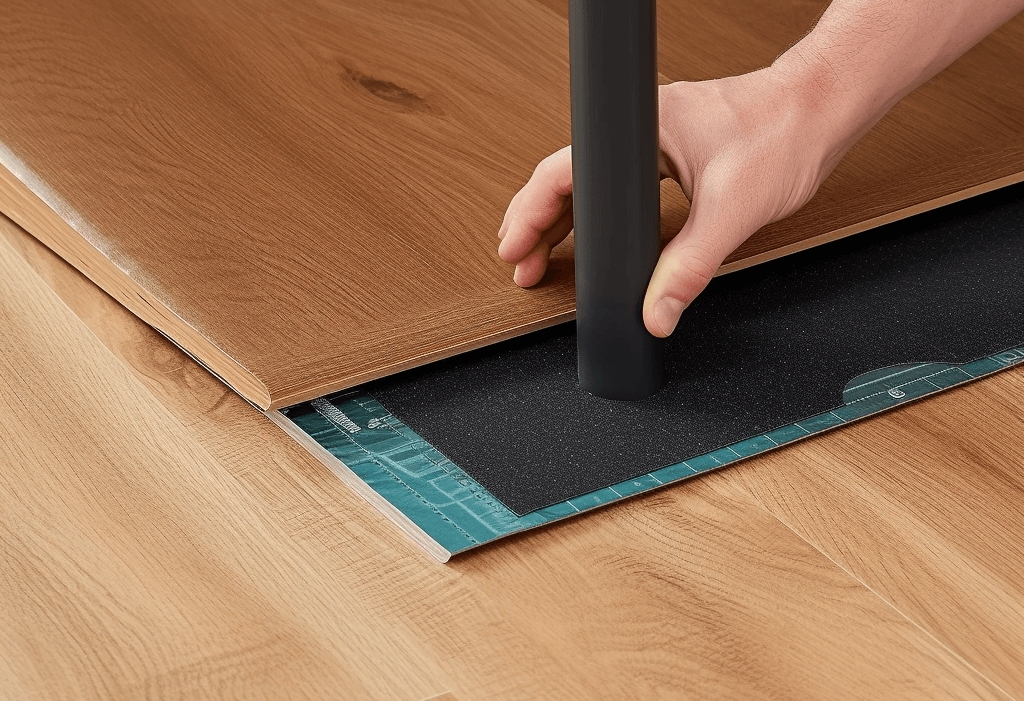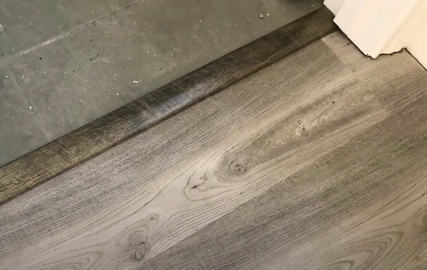DIY Guide: How to Fix and Prevent Dents in Vinyl Flooring
Uncover the secrets to restoring your vinyl flooring. From removing dents to preventing them, our guide offers practical advice to keep your floors in top shape.

Vinyl flooring is a favored choice among homeowners due to its durability and cost-effectiveness. However, despite our best efforts, accidents can occur. Dents in vinyl flooring can result from heavy furniture, dropped objects, or even high heels. Fortunately, with the correct techniques, dents can be removed without needing to replace the entire floor.
In this comprehensive guide, we will cover all you need to know about removing, repairing, and preventing dents in vinyl flooring. We will begin by understanding the composition of vinyl flooring and the causes of dents.
Next, we will guide you through detailed instructions on how to remove dents, including both shallow and deep ones. We will also provide practical tips on how to prevent dents from occurring initially.
With this guide, you can ensure that your vinyl flooring will maintain its pristine condition for years to come.
Understanding Vinyl Flooring

Vinyl flooring, a popular choice among many homeowners, is known for its durability, cost-effectiveness, and ease of maintenance.
However, like any flooring material, vinyl is not immune to common issues such as dents and scratches. In this section, we’ll delve into how to remove, repair, and prevent dents in vinyl flooring to keep your floors looking their best.
Introduction to Vinyl Flooring
If you’re seeking a durable and cost-effective option for your home’s floors, there’s a high chance you’ve considered vinyl floors. Vinyl plank flooring, cushioned vinyl flooring, and other types of vinyl flooring are gaining popularity due to their durability, cost-effectiveness, and versatility. They’re also easy to install and maintain, making them an excellent choice for homeowners who want to update their floors without straining their budget.
Here are three things you need to know about vinyl flooring:
- Vinyl flooring is available in a variety of styles and designs, mimicking the look of hardwood, tile, and other types of flooring.
- Cushioned vinyl flooring has a soft, padded backing that provides extra comfort underfoot.
- While vinyl flooring is durable, it can still be susceptible to dents from heavy furniture, high heels, and other sources of pressure. But don’t worry, there are ways to repair and prevent these dents from damaging your floors.
Benefits of Vinyl Flooring
The advantages of vinyl floors include their cost-effectiveness, durability, and versatility, making them a popular choice for homeowners seeking stylish and long-lasting flooring options. Vinyl flooring is available in a variety of styles, including luxury vinyl tile, vinyl plank floors, flexible vinyl planks, rigid vinyl planks, and sheet vinyl. Each style has its unique features, and homeowners can choose a design that best suits their needs and preferences.
Luxury vinyl tile, for instance, is a premium vinyl flooring option that mimics the look of natural stone or ceramic tiles. Vinyl plank floors, on the other hand, offer a wood-like appearance and are perfect for homeowners who want the look of hardwood floors without the high cost and maintenance. Flexible vinyl planks are ideal for uneven subfloors, while rigid vinyl planks are more resistant to dents and scratches. Lastly, sheet vinyl is a practical option for high-moisture areas such as bathrooms and laundry rooms. With its many styles and advantages, vinyl flooring is a great investment for any homeowner.
Common Issues with Vinyl Flooring (including dents)
It’s frustrating when you can feel the uneven dips and bumps under your feet as you walk across your supposedly smooth and flawless floors. Unfortunately, this is a common issue with vinyl flooring. Dents can occur from heavy furniture, dropped objects, or even from high heels.
The good news is that there are ways to remove and repair these unsightly dents. One methodis to use a heat gun to soften the vinyl around the dent, then use a putty knife to gently lift the dent back up. Another option is to place a damp paper towel over the dent and use a hot iron to heat up the area. The steam from the towel will help to lift the dent.
Prevention is also key to avoiding dents on vinyl floors. Using furniture pads under heavy furniture and avoiding high heels on vinyl floors can help to prevent dents from occurring in the first place.
How to Get Dents Out of Vinyl Flooring

Dents in vinyl flooring can be frustrating, especially when they mar the beauty of your new flooring.
But don’t worry, we’ve got you covered with a step-by-step guide on how to fix dents in vinyl flooring. We’ll also share some tips to ensure you effectively get those dents out without damaging your flooring.
The Challenge of Fixing Dents in Vinyl Flooring
As we delve into this issue, let’s first explore the challenge presented by the impact of heavy objects on the surface of this material.
Vinyl flooring is known for its durability, but it’s not completely impervious to dents and scratches. When heavy furniture or appliances are moved across the surface of a soft vinyl floor, they can leave behind unsightly dents that are difficult to fix.
These dents not only detract from the appearance of the flooring but can also create tripping hazards. To address this problem, it’s important to understand the nature of the dents in vinyl flooring.
Unlike scratches, which only affect the surface of the material, dents actually damage the structure of the flooring. This means that simply rubbing them out with a paper towel or putty knife won’t work.
Instead, it’s essential to take a more comprehensive approach to removing and preventing dents, which we’ll cover in the following sections.
Step-by-Step Guide on How to Remove Dents from Vinyl Flooring
Now you’ll learn how to get rid of those annoying marks left by heavy objects on your vinyl floor, by following these simple steps.
First, gather some materials, such as paper towels, a putty knife, warm water, and a heat gun. Then, follow these steps:
- Start by removing any loose dirt or debris from the dent with a soft-bristled brush or vacuum cleaner.
- Dampen a paper towel with warm water and place it over the dent, letting it sit for a few minutes to help soften the vinyl.
- Use the putty knife to gently push the edges of the dent back into place, working from the outside in.
- If the dent is still visible, use a heat gun on its lowest setting to warm up the vinyl. This’ll make it more pliable and easier to manipulate.
- Once the vinyl is warm, use the putty knife to push the edges of the dent back into place again, working from the outside in.
- Finally, wipe the vinyl floor clean with a damp cloth to remove any remaining dirt or debris.
By following these steps, you can fix dents in your vinyl flooring quickly and easily.
It’s important to note, however, that prevention is always better than cure. So, make sure to take steps to prevent future dents by using furniture pads, avoiding heavy objects on your vinyl floor, and keeping it clean and well-maintained.
How to Prevent Dents in Vinyl Flooring

Vinyl flooring is a popular choice for many homeowners due to its durability and ease of maintenance. However, like any flooring material, it can be susceptible to dents and scratches. In this section, we’ll discuss some strategies to prevent dents in vinyl flooring.
Understanding the Causes of Dents in Vinyl Flooring
Before we delve into prevention strategies, it’s important to understand what causes dents in vinyl flooring. Dents can occur when heavy objects are placed or dropped on the floor. This can include furniture, appliances, or even high heels. The pressure from these objects can cause the vinyl to deform, resulting in a dent.
Strategies to Prevent Dents in Vinyl Flooring
Now that we understand what causes dents, let’s discuss some strategies to prevent them.
- Use Furniture Pads: One of the most effective ways to prevent dents is to use furniture pads. These pads can be placed under the legs of heavy furniture to distribute the weight and prevent dents.
- Avoid High Heels: High heels can cause dents in vinyl flooring due to the high amount of pressure exerted on a small area. Avoid wearing high heels on vinyl floors whenever possible.
- Lift, Don’t Drag: When moving heavy objects, lift them instead of dragging them across the floor. Dragging can cause scratches and dents in the vinyl.
- Regular Maintenance: Regularly clean and maintain your vinyl floors to keep them in good condition. This includes sweeping or vacuuming to remove dirt and debris that can cause scratches and dents.
By following these strategies, you can help prevent dents in your vinyl flooring and keep it looking its best for years to come.
Frequently Asked Questions
Conclusion
So there you have it, our master guide on how to remove, fix, and prevent dents in vinyl flooring. We hope that this article has been helpful in guiding you through the process of dealing with unsightly dents in your vinyl floors, whether they’re caused by heavy furniture, high heels, or other sources.
Remember, prevention’s always better than cure. By taking the necessary precautions and being mindful of what you place on your vinyl floors, you can avoid dents altogether.
But if you do end up with dents, don’t worry – with a little bit of effort and the right tools, you can easily fix them and restore your floors to their former glory.


